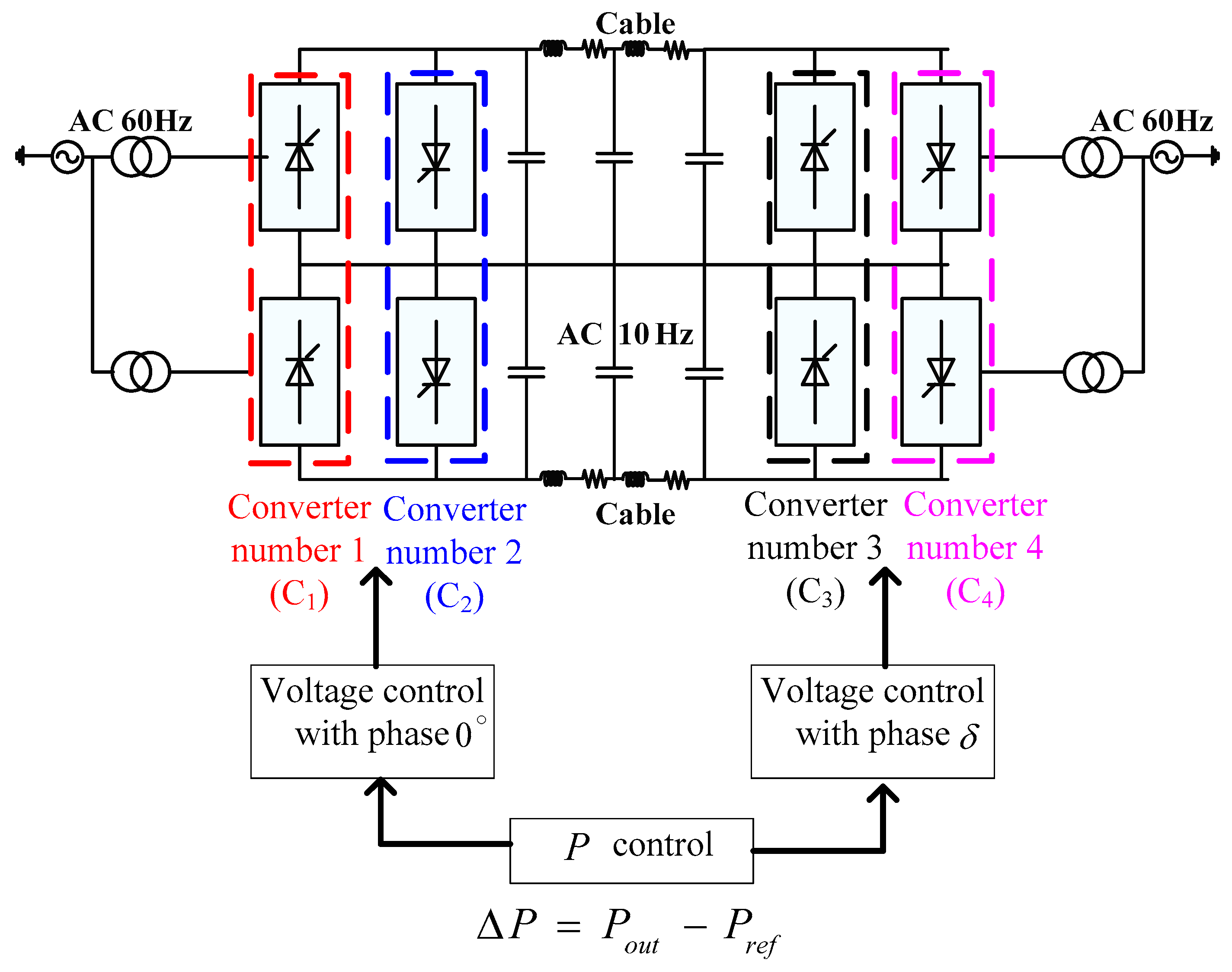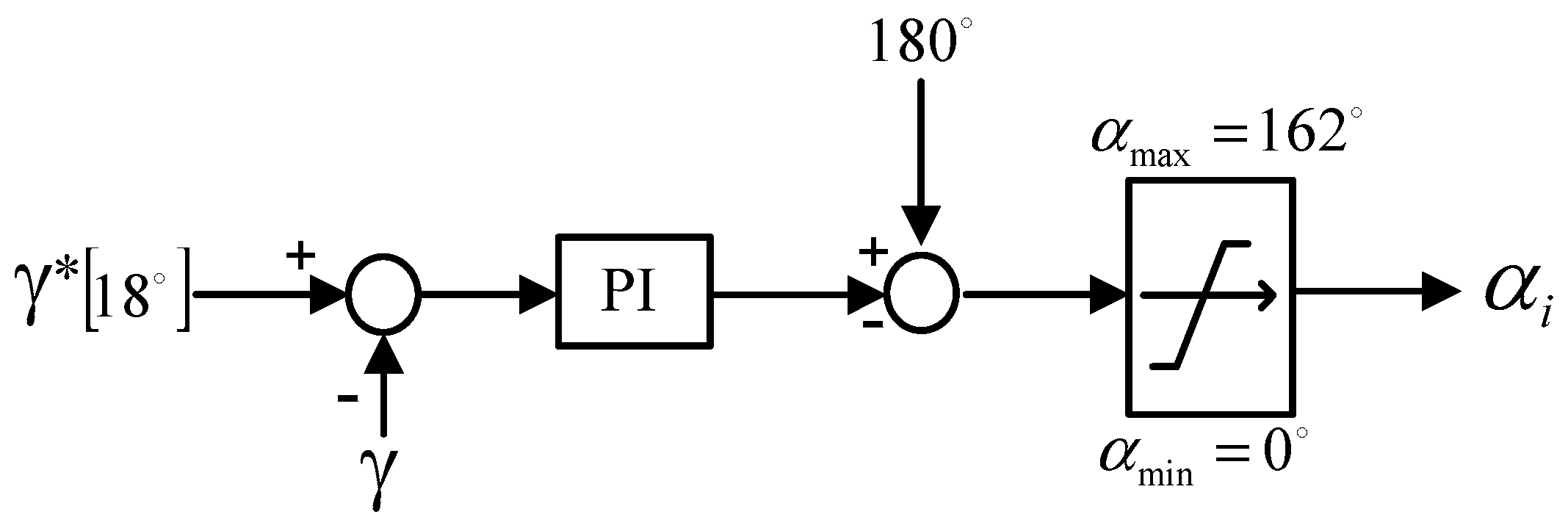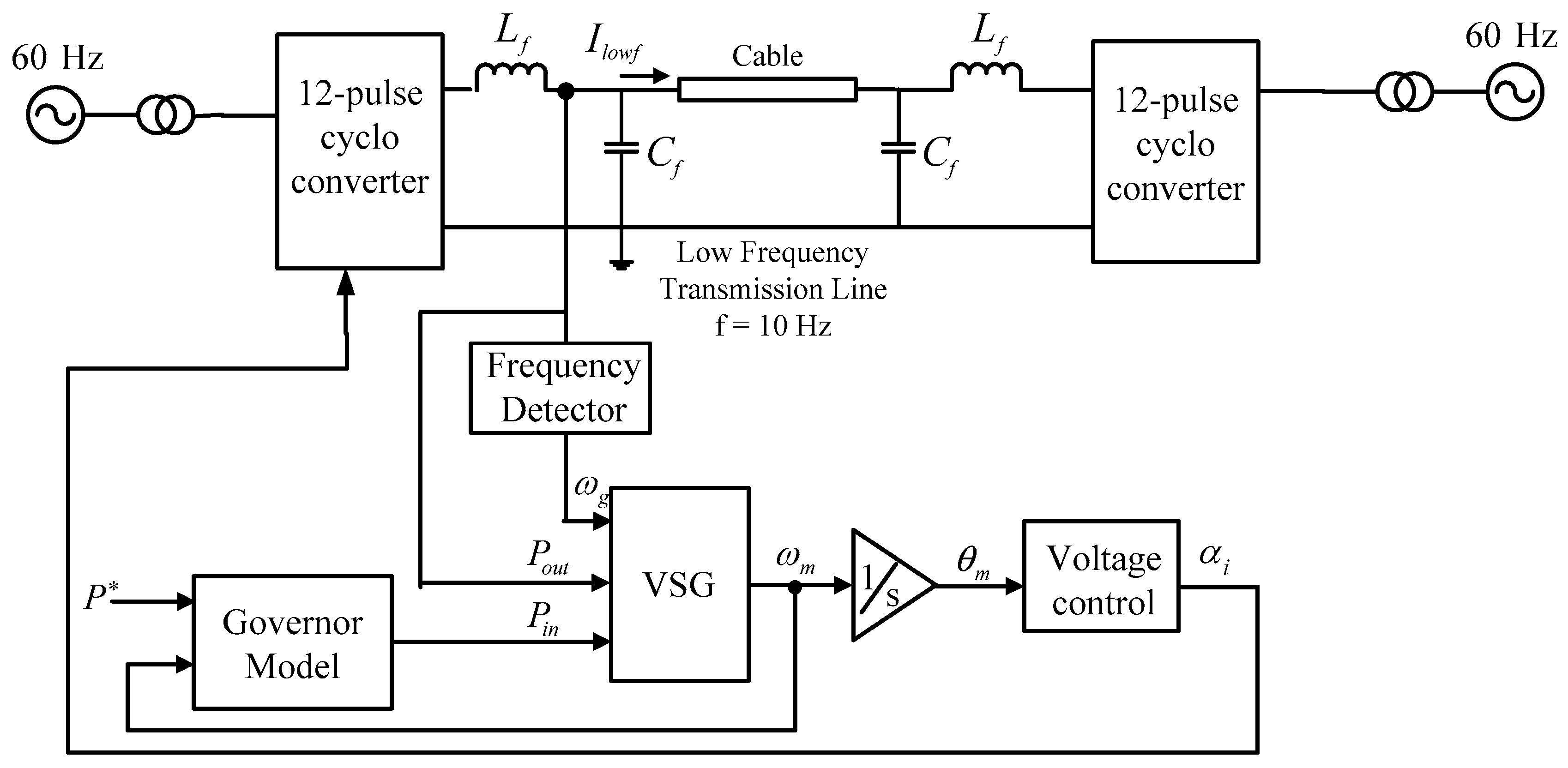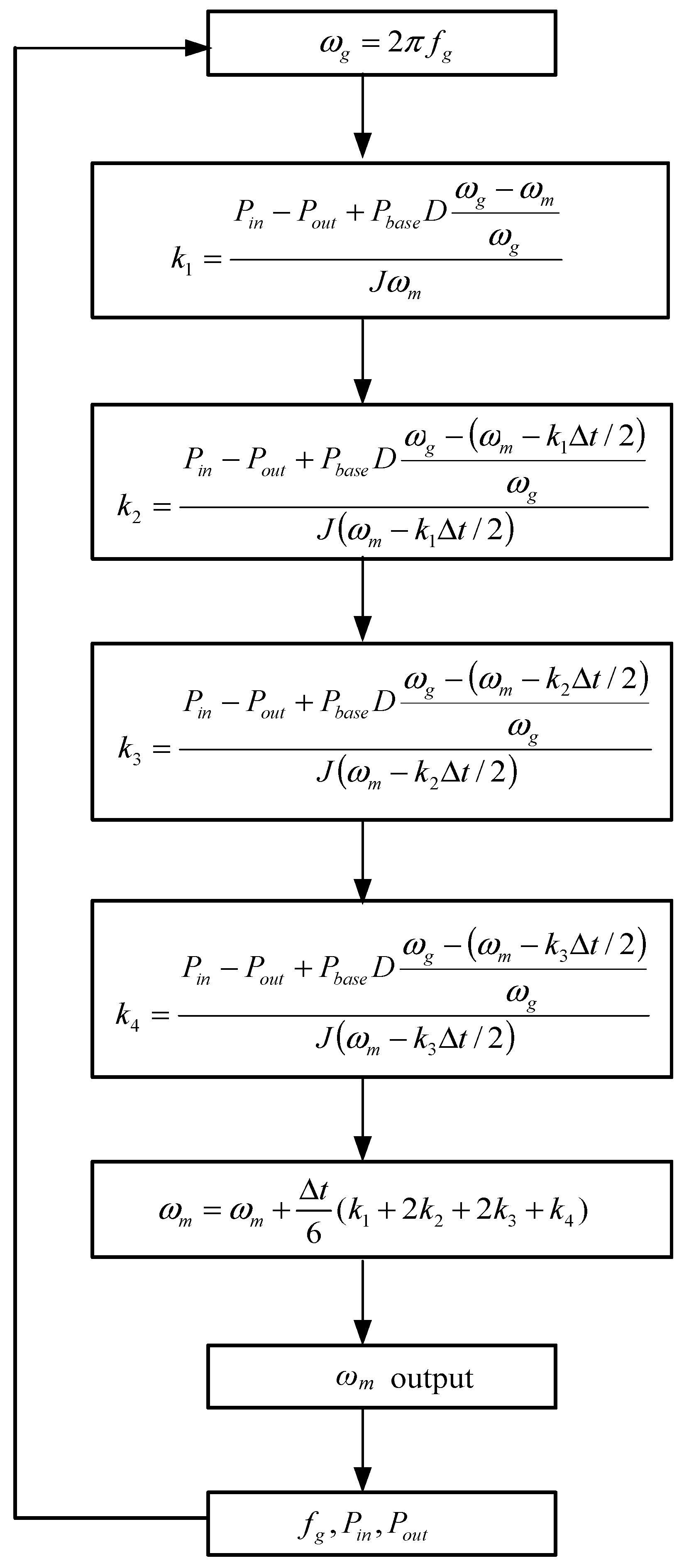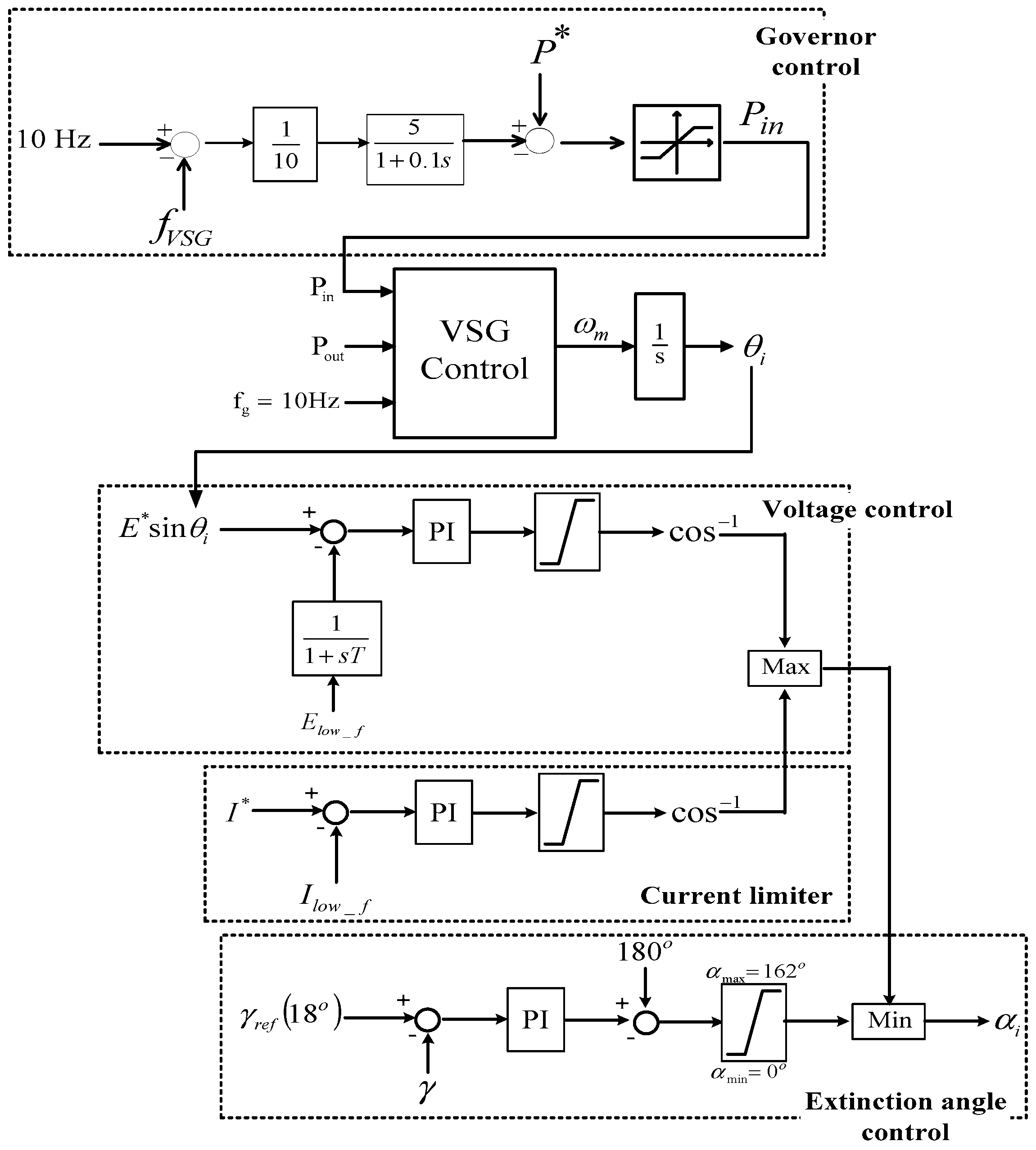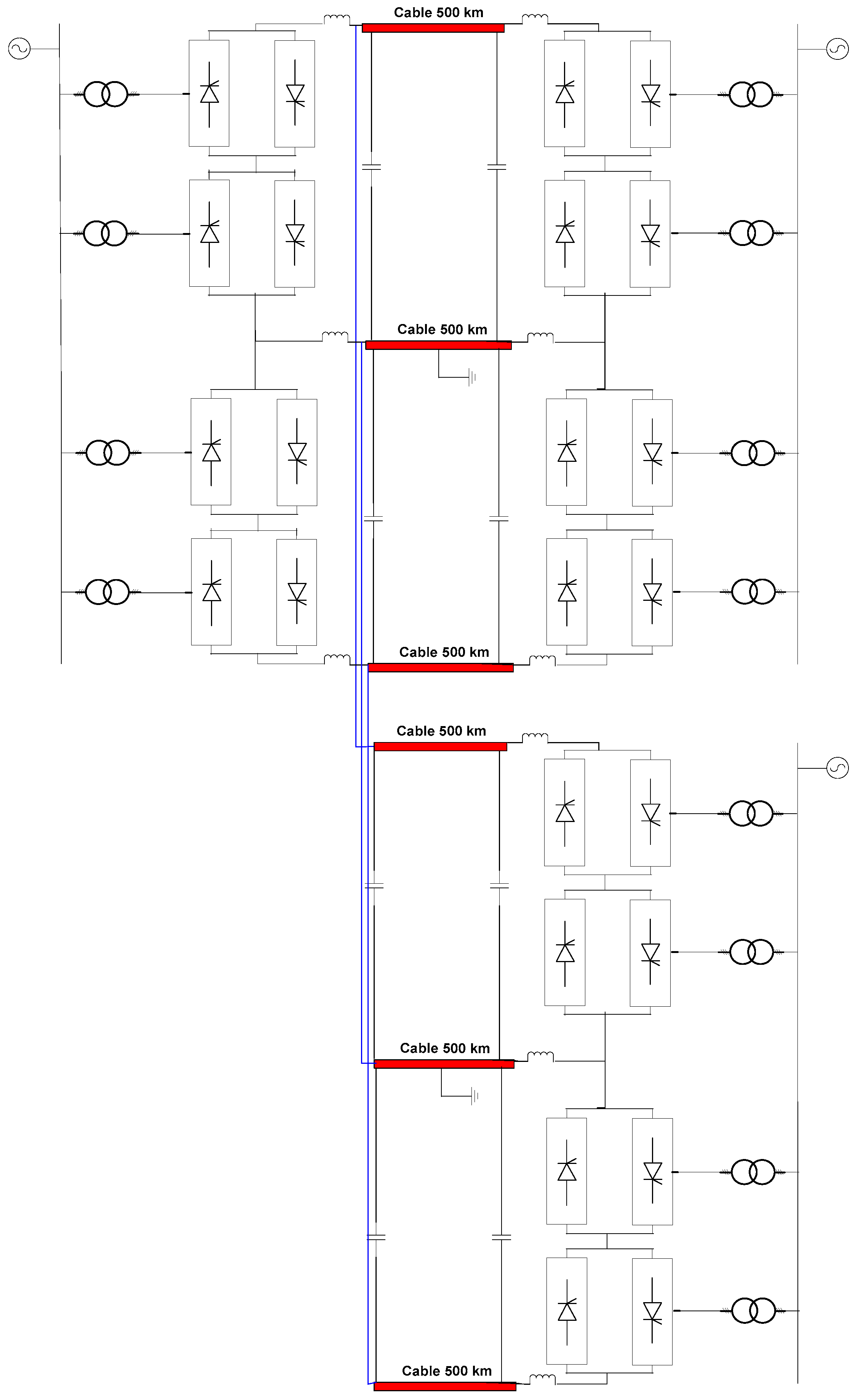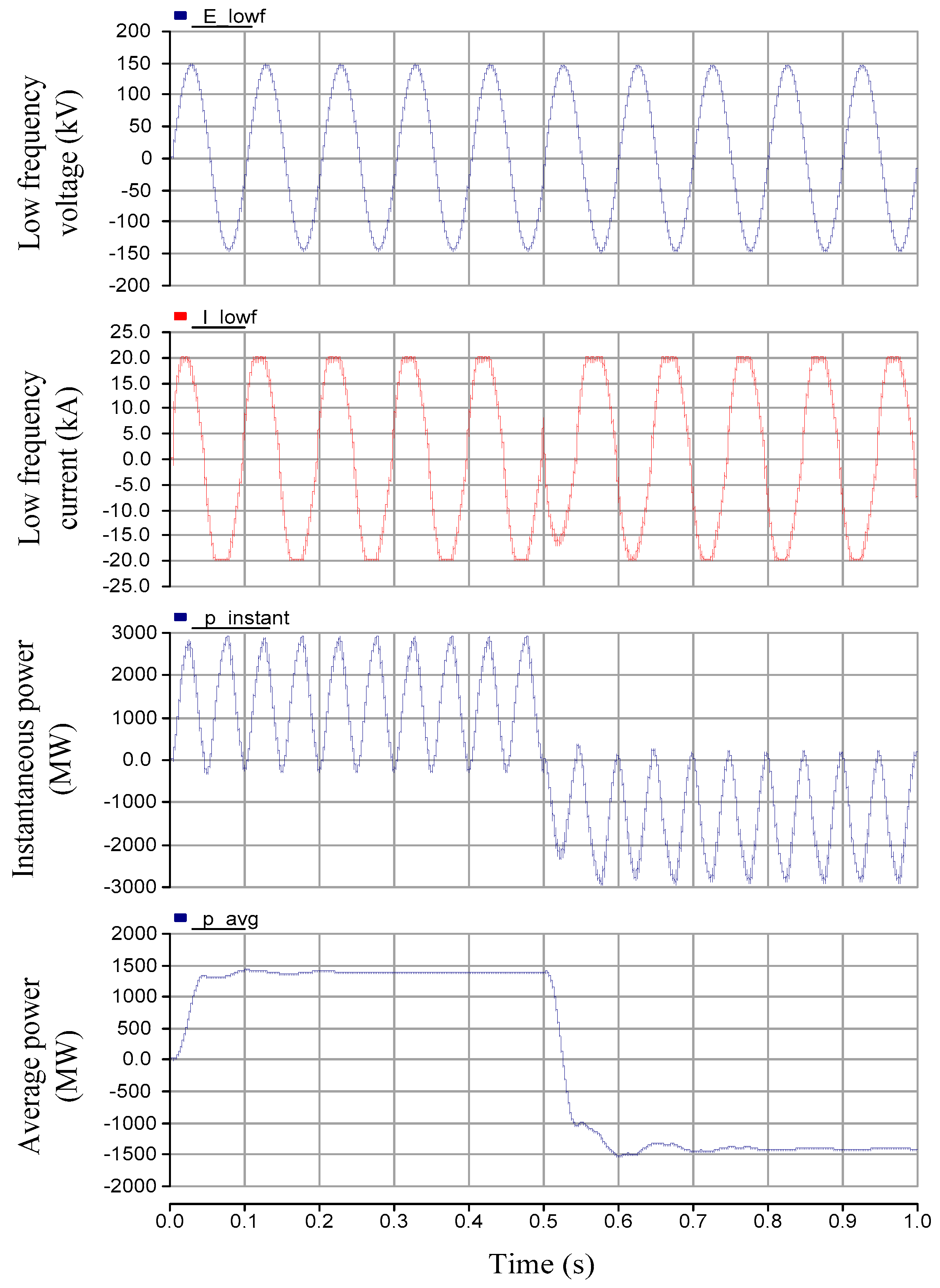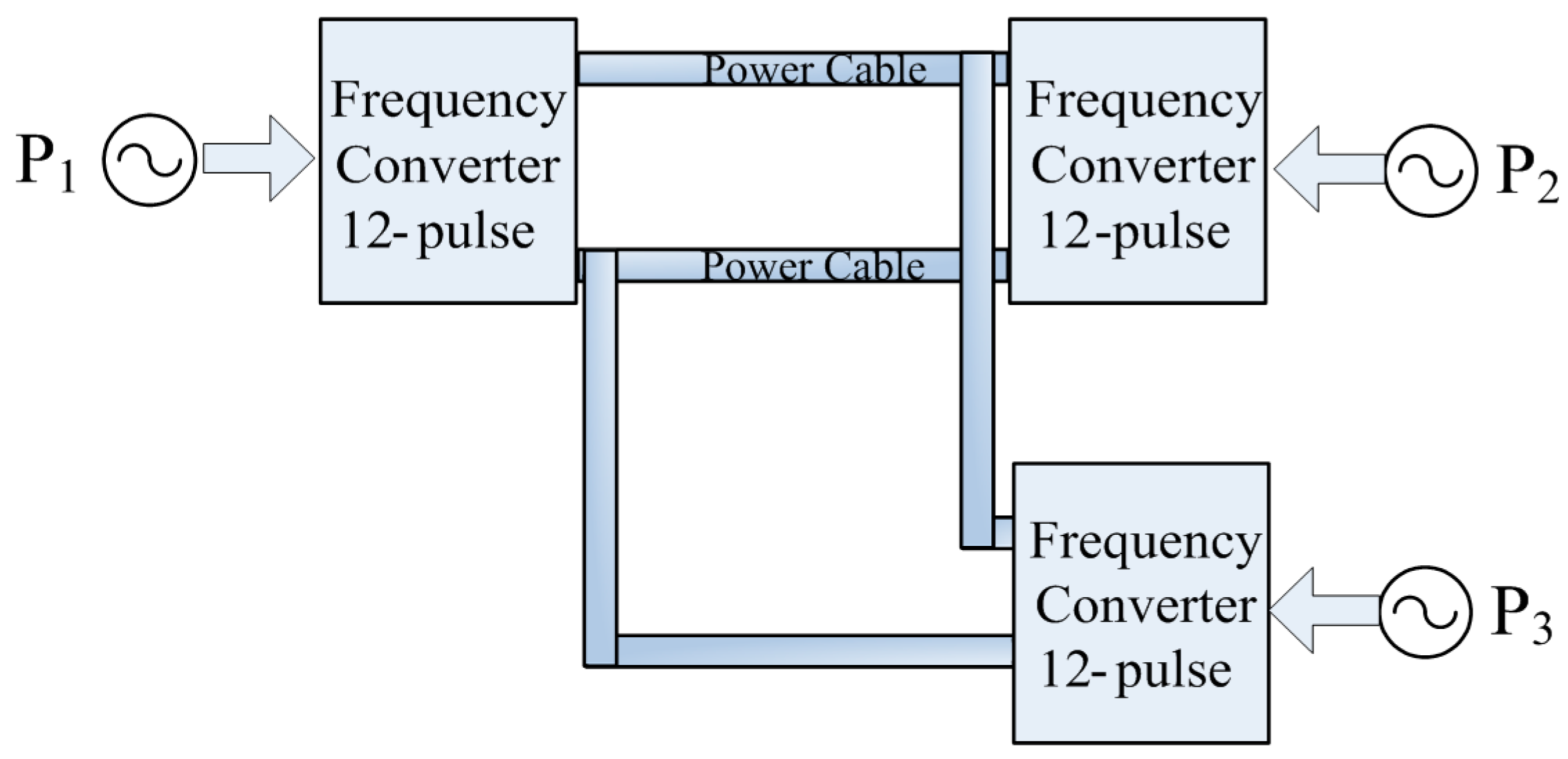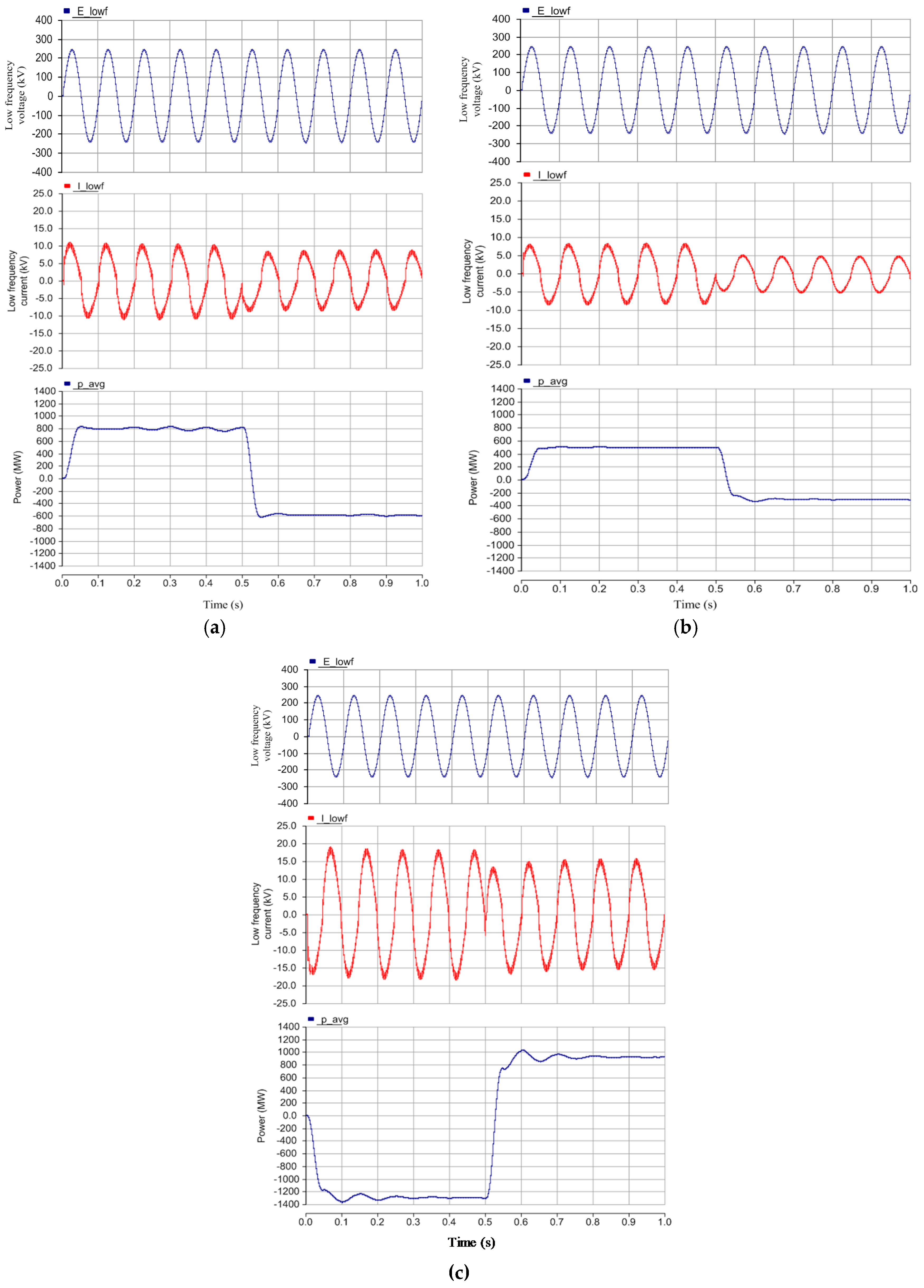1. Introduction
The low frequency AC transmission system (LFAC) can be considered as promising for a long distance, large scale transmission system using line-commutated converters. One of the promising applications of this system is the operation on a multi-terminal system [
1]. The integration of other types of power plants such as offshore wind power, High Voltage Direct Current (HVDC) or multi-terminal HVDC transmission with the main power grid are subjects of ongoing research [
2,
3]. In the case of LFAC, it could be easier to integrate the existing AC power plant because it can be built with commercially available power system components such as transformers and cables designed for regular frequency [
4]. The transformer could be derated by a factor of transmitting frequency, with the same rated current, but partially containing the original rated voltage [
5]. Given this information, the installation of LFAC can be easily paralleled with the existing transmission line.
For the application on the multi-terminal system with line-commutated converters, the operation of multi-terminal HVDC is complicated [
6]. It is difficult to control power flow directions among terminals without an extra DC power flow controller, which requires greater complexity, a greater number of devices and extra costs.
In terms of the power control scheme for this LFAC transmission system, to date only one reference can be found. The concept of the power control method for the two-terminal system has been briefly mentioned in [
7]. However, no details on the power control scheme were presented. In addition, the cycloconverters do not have synchronizing power with respect to the low frequency side. Therefore, absolute phase reference on the low frequency side is required to synchronize power for the low frequency output assisted by the reference time signal from the global positioning system (GPS) or synchronous digital hierarchy (SDH), which is difficult to operate in the multi-terminal system application [
8,
9,
10].
The goal of this paper is to present a new power control method for application on the multi-terminal LFAC transmission system. The controller is designed by using the advantages of a visual synchronous generator (VSG) with a governor control [
11]. The voltage control is introduced to generate firing angles to the cycloconverters. The current limiter and extinction angle control are included for overcurrent and commutation failure protection of the converters. VSG with a governor control is applied to control the amount of power transmission in the LFAC multi-terminal system application. Furthermore, the proposed control scheme is applied in a two-phase multi-terminal system of LFAC to perform and verify the control operation by PSCAD/EMTDC Software (version 4.2.1, Winnipeg, MB, Canada).
2. Control Strategies for LFAC for the Two-Terminal System
The basic operation of the LFAC transmission system can be described by considering two terminals: sending and receiving ends. A cycloconverter is applied to lower the line frequency from 50/60 Hz to a smaller amount. At the receiving end, another cycloconverter is operated to convert the fraction frequency back to the grid frequency. These two conversions obtain firing angle signals from the designed control scheme, which is achieved by the different phase angles of different terminals. This is one of the common control methods of the LFAC transmitting power control. The active transmitting power over transmission lines can be expressed by Equation (1).
where
is the sending end voltage,
is the receiving end voltage,
X is line reactance, and δ is the transmitting angle.
As indicated by Equation (1), the voltage control scheme concept with the LFAC transmission system can be described in
Figure 1.
As shown in
Figure 1, at the sending end, the phase is set to the constant value of 0° and the amount of transmitting power is determined by the phase difference from the receiving end.
A cycloconverter operates by following the modes in
Table 1. On the low frequency side, a positive current waveform can be obtained from converter number 1 and number 4 operations. During the zero crossing point, all converters are blocked by the blocking signal from the controller. The negative current waveform can be received from converter number 3 and number 2 by reversing the current direction.
2.1. The Proposed Voltage Control Scheme
Considering the mode control of the cycloconverter, this converter works as a two-set of HVDC anti-parallel connections and their inputs are a sinusoidal waveform instead of a constant value. From this point of view, the voltage control scheme can be designed by using HVDC concepts, in which the operation is much easier to understand.
From
Figure 2, the Equation (2) is obtained to design the voltage control scheme of the LFAC by substituting
(DC voltage) with
(voltage on low frequency side) in
Figure 3, and
is the root mean square (
RMS) value of 60 Hz-side AC line to line voltage. The designed control block diagram is shown in
Figure 3, in which the voltage reference value of the low frequency side
=
is for reference angle side,
is on another side and
is the measured instantaneous voltage on low frequency side.
To obtain the phase reference (
), the power control scheme needs to be considered. Equation (1) shows the amount of transmitting power between two terminals following the reference power. Furthermore, power on the low frequency side is not constant, thus the moving average control method is adopted to average the amount of power on the low frequency side. The power control block diagram can be achieved as shown in
Figure 4.
To control the amount of transmitting power between each terminal, the power control scheme is chosen for application to the cycloconverters in the LFAC transmission system. According to the system circuit mode and transmitting power in (1), power reference (P*) is compared with average power (Pavg) to obtain the phase difference () for the voltage reference.
2.2. Proposed Frameworks for Current Limiter and Extinction Angle Control
For protection from overcurrent and commutation failure, a current limiter and extinction angle control are applied in this system. The current limiter is used to limit overcurrent during the transmission of power where
the measured instantaneous current on the low frequency side. The current control scheme is shown in
Figure 5.
For line-commutated converters, in practice, there are some overlapping angles due to the commutation reactance. The constant extinction angle control (γ) is used to avoid commutation failure. As shown in
Figure 6, this extinction angle control works by comparing gamma reference with gamma measure, then the minimum firing angle is chosen to be the gating pulse for cycloconverters. The typical value of extinction angle (γ) is set at 18° for 60 Hz of the AC system.
During the zero cross point current, a gate block control scheme is applied to every converter as shown in
Figure 7.
In the complete developed control scheme of LFAC, as shown in
Figure 8, the same control system is applied for every converter to control the amount of transmitting power between terminals. Following the converter operation mode,
is set at
for one side of the converter. On another side of the converter,
depends on the reference of transmitting power to control the amount and direction.
3. Control Strategies for Multi-Terminal LFAC
The proposed control scheme to control the amount of transmitting power and direction among several terminals is explained in this section. In a multi-terminal application of LFAC (LCC-MTLF), a VSG is introduced to synchronize the phase and frequency among terminals instead of a communication link or GPS. The VSG model is based on the swing equation of synchronous generators. Based on this equation, the relation between the output power
and the input power
is shown in Equation (3).
where
is the virtual rotating angular frequency,
is the angular frequency,
is the moment of inertia of rotating mass, and
D is the damping factor of the damping power introduced by the damp winding.
The concept of VSG control is shown in
Figure 9. For the power balance between
and
, according to the concept of VSG control, if the network frequency is lower than the reference frequency (
), then the generator increases its power into the network.
Figure 10 shows the VSG control scheme applied to the LFAC transmission system. The VSG control is emulated to the swing equation in the VSG block.
For simplification, the damping factor
D is considered as a small constant parameter. As the swing equation is a differential equation, an algorithm based on the Runge–Kutta iterative method is used to solve the angular frequency
following the flow chart as shown in
Figure 11. The calculated
provides the frequency reference for the governor model and phase reference
through an integrator.
Pbase is the rated capacity of transmission power.
The block of the governor model is shown in
Figure 12. The governor model is implemented to tune the input power command based on the frequency deviation. The transfer function of the governor control can be expressed as Equation (4), where
Kp = 5,
Td = 0.1.
In the VSG control part as shown in
Figure 13,
Pin,
Pout and low frequency side frequency
are inputs of the VSG control unit. In each control cycle, the momentary
is calculated via the application of the fourth-order Runge–Kutta iterative method inside the VSG block to generate the virtual phase angle
(
i = 1, 2, 3) sent through the voltage control unit.
As for the voltage control scheme, the concept of the control operation is the same as the voltage control scheme as described in
Section 2.1. When a disturbance occurs, or more load shares are added to the system, the system can stabilize itself by regulating voltage using this control.
The current limiter works by comparing the rating current with measured current from the low frequency side to generate the firing angle to the cycloconverter, which can limit overcurrent by limiting the firing angle to the cycloconverter. Also, extinction angle control (γ) is included to avoid commutation failure in a converter.
By combining each part of the control scheme, the complete control scheme of the multi-terminal LFAC transmission system is shown in
Figure 14. The voltage control receives the virtual phase angle
from the VSG block to be the voltage reference, then the firing angle
is generated and is sent to the cycloconverters.
